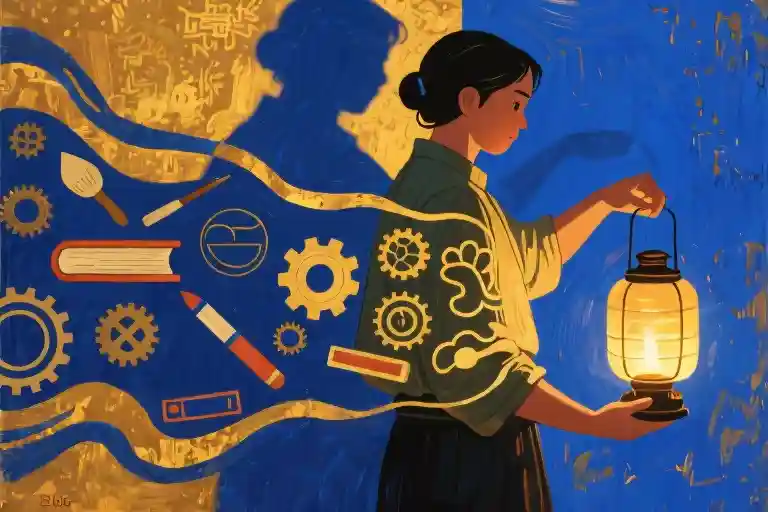The first time I stumbled upon Carl Jung’s words, it felt like someone had flipped a switch in my brain. There I was, scrolling through psychology articles late at night when his quote “Knowing your own darkness is the best method for dealing with the darknesses of other people” stopped me mid-swipe. As someone who’d spent years collecting self-help advice like trading cards, I’d never encountered anything that cut so deep yet felt so immediately practical.
What makes Jungian psychology uniquely valuable isn’t just its intellectual depth—it’s how effortlessly these 100-year-old insights translate into modern life tools. Where other psychological approaches might require a PhD to decipher, Jung gives us something we can use before breakfast: simple frameworks for understanding why we judge others harshly, how our unresolved wounds shape daily reactions, and where our true potential might be hiding.
This isn’t about memorizing complex theories. Over the next sections, we’ll break down three of Jung’s most actionable ideas into real-world practices:
- A 5-minute “shadow spotting” technique to catch judgmental thoughts in real-time
- How to reinterpret recurring conflicts as clues about your hidden traits
- Turning uncomfortable emotions into creative fuel using Jung’s “active imagination” method
What surprised me most wasn’t just discovering these tools—it was realizing how much energy I’d wasted resisting my so-called “dark side” instead of learning from it. Jung’s perspective flips the script: those messy, inconvenient parts of ourselves aren’t flaws to fix but untapped resources waiting to be understood. As we’ll see, this shift changes everything from workplace dynamics to midlife transitions.
For now, consider this: when was the last time you paused mid-argument and wondered, “What does this reaction say about me?” That simple question—one we’ll expand on throughout this guide—is where practical Jungian psychology begins.
“Knowing your own darkness is the best method for dealing with the darknesses of other people.”
Carl Jung’s shadow theory reveals something fascinating about human nature – the traits we dislike in others are often reflections of what we deny in ourselves. That critical voice pointing fingers outward? It’s usually whispering truths about our own unacknowledged flaws.
Understanding Your Shadow Side
The ‘shadow’ represents everything we consciously reject about ourselves – our hidden insecurities, suppressed emotions, and socially unacceptable impulses. Jung believed these disowned parts don’t disappear; they simply manifest in distorted ways. When we encounter someone embodying these traits, we often react with disproportionate irritation or judgment.
Take workplace dynamics as an example. Sarah, a marketing executive, constantly complained about her colleague’s ‘obsessive attention to detail.’ Through shadow work, she realized this criticism stemmed from her own shame about missed deadlines due to procrastination. Her colleague’s precision mirrored what Sarah lacked – and resented.
The Mirror Effect in Relationships
This psychological mirroring happens constantly:
- The friend who judges ‘selfish people’ while neglecting their own needs
- The parent who criticizes a child’s laziness while ignoring their own burnout
- The partner who accuses others of being ‘too emotional’ while suppressing feelings
When we spot these reactive patterns, Jung suggests pausing to ask: What part of myself might this person be reflecting?
Your 7-Day Shadow Work Challenge
Building self-awareness requires practical tools. Try this structured approach:
Day 1-3: Observation Phase
- Carry a small notebook (or use your phone)
- Whenever you feel strong judgment toward someone, jot down:
- The specific behavior triggering you
- Your emotional reaction (anger, disgust, envy)
- Any physical sensations (clenched jaw, stomach tightness)
Day 4-5: Pattern Recognition
- Review your notes looking for:
- Recurring types of behaviors that upset you
- Situations where your reaction felt disproportionate
- Potential connections to your own insecurities
Day 6-7: Integration Exercise
For each identified pattern:
- Complete this sentence: “When I see [behavior], it bothers me because deep down I fear…”
- Recall one instance where you displayed a similar trait (even mildly)
- Write a compassionate note to your shadow self: “I see you, and you’re part of me.”
The Liberating Truth
Shadow work isn’t about self-flagellation – it’s about reclaiming power. That colleague who ‘never stops working’? Your irritation might reveal your own difficulty setting boundaries. The friend who’s ‘too needy’? Perhaps they mirror your fear of asking for help.
As Jung reminds us, “Unless you learn to face your own shadows, you will continue to see them in others, because the world outside you is only a reflection of the world inside you.” By making peace with our darkness, we stop projecting it onto others – and that’s when real growth begins.
Journal Prompt: What’s one judgment you frequently make about others that might reveal something about yourself? How could acknowledging this change your relationships?
“Life Really Does Begin at 40. Up Until Then, You Are Just Doing Research.”
Carl Jung’s provocative statement about midlife isn’t just poetic optimism—it’s backed by surprising data. A Harvard Business School study found that the average age of successful startup founders is 45, while neuroscience research shows our brains reach peak emotional intelligence in our late 40s. Julia Child published her first cookbook at 49, Stan Lee created his most iconic Marvel characters at 39, and Vera Wang entered fashion design at 40. These aren’t exceptions; they’re proof of Jung’s radical premise: your accumulated experience becomes combustible fuel for reinvention.
The Three Traits of Successful Midlife Transformers
- Pattern Recognition (Your Secret Superpower)
By 40, you’ve unconsciously cataloged thousands of life/work patterns—what psychologist Karl Weick calls “wisdom of the experienced novice.” Unlike rigid expertise, this lets you spot unconventional connections (e.g., a teacher-turned-entrepreneur recognizing how classroom dynamics apply to team management). - Emotional Calibration
The prefrontal cortex finally matures around 45, granting what Jung called “the patience of the second half of life.” Where 25-year-old you saw obstacles, 45-year-old you sees interesting puzzles (with better emotional regulation to handle setbacks). - Permission to Edit
Midlife transformers ruthlessly curate their commitments. They adopt Jung’s concept of “necessary neglect”—consciously choosing what NOT to pursue—like Ray Kroc focusing solely on franchising when he took over McDonald’s at 52.
Your Second-Life Blueprint (With Downloadable Template)
Jungian therapists use this 3-part framework with clients navigating midlife transitions:
- Archaeology Phase
- List every paid/unpaid role you’ve ever had (babysitter, volunteer, manager, etc.)
- Circle 3 where you felt “in flow”—not because you were good at them, but because time disappeared
- Alchemy Phase
For each “flow” role:
- Identify transferable superpowers (e.g., “As a bartender, I became expert at reading unspoken tensions” → conflict mediation skills)
- Note which still energize you (Some childhood passions reawaken in midlife with new context)
- Architecture Phase
Build your next chapter using:
- 30% proven skills (financial stability anchors)
- 40% rediscovered passions (creative fulfillment)
- 30% experimental learning (preventing stagnation)
[Download the interactive Second-Life Planner here] with journal prompts and skill-mapping exercises.
The Jungian Warning: What This Quote DOESN’T Mean
Some misinterpret Jung’s words as permission to:
- Blame past failures on “just researching” (Actual research requires intentional reflection)
- Make impulsive changes (Your 20s’ trial-and-error approach now needs strategic sequencing)
- Chase arbitrary milestones (“If Julia Child did it at 49…”—your timeline is unique)
True Jungian midlife growth means:
- Mining your history for hidden gold (That abandoned art hobby? Maybe it’s now your side hustle)
- Leveraging hard-won emotional resilience (Your divorce survival skills make you a gifted relationship coach)
- Embracing “productive ambiguity” (Unlike rigid 25-year-old plans, your 45-year-old self can tolerate not having all answers)
As Jung wrote elsewhere: “The afternoon of life is just as full of meaning as the morning, only its meaning and purpose are different.” Your 40s aren’t a second youth—they’re the first chapter of your most intentional, integrated self.
Practical Jungian Exercises for Daily Life
Carl Jung’s theories often seem profound yet distant from our daily routines. But what if I told you that some of his most powerful psychological tools can be seamlessly woven into your everyday life? Here are two transformative practices distilled from Jungian psychology that require no therapist’s couch—just curiosity and consistency.
Dream Analysis: Your Nightly Self-Therapy Session
Jung considered dreams “the royal road to the unconscious.” Unlike Freud who saw dreams as wish fulfillment, Jung viewed them as compensatory—balancing what our conscious mind overlooks. Here’s how to decode yours:
Step 1: The Capture
Keep a notebook by your bed (or use a voice memo app). Upon waking, record:
- 3 key images/symbols (e.g., a locked door, your childhood home)
- Dominant emotions (anxiety? exhilaration?)
- Any bizarre “dream logic” (flying without wings, talking animals)
Step 2: Symbol Translation
Jung believed dream symbols are personal yet tap into universal archetypes. Create your dream dictionary by asking:
- Where have I encountered this symbol in waking life?
- What personal associations does it carry? (e.g., A snake might represent betrayal to someone bitten as a child, but healing to a medical professional)
Pro Tip: Recurring dreams often signal unresolved conflicts. Notice patterns over 2-4 weeks.
Step 3: Emotional Integration
Ask yourself: “If this dream were a play, what message is my unconscious staging for me?” A client once dreamed of drowning while colleagues partied onshore—it revealed her unacknowledged burnout.
Active Imagination: Dialoguing with Your Inner Cast
This technique bridges conscious and unconscious minds through structured daydreaming. Think of it as a mindfulness practice with Jungian flair.
The 15-Minute Guide:
- Set the Stage: Choose a quiet moment. Focus on a persistent emotion or dilemma.
- Meet Your Inner Figures: Imagine the emotion/issue as a character. What do they look like? (Your anger might appear as a red-faced judge, creativity as a messy artist)
- The Conversation: Ask open questions like:
- “What are you trying to show me?”
- “What do you need from me?”
Let answers arise spontaneously—no censoring!
- Closure: Thank the figure. Journal insights immediately.
Real-Life Application: Sarah, a perfectionist executive, visualized her “inner critic” as a Victorian schoolmarm. Through dialogue, she discovered this part feared chaos, not failure. This reframing helped her delegate more comfortably.
Why These Work
- For Shadow Work: Dreams often showcase repressed aspects of ourselves. That nightmare about being chased? It might be your neglected ambition trying to get your attention.
- For Midlife Transitions: Active imagination helps reconcile “who I was” with “who I’m becoming”—crucial for Jung’s “life begins at 40” philosophy.
Safety Note: These methods are exploratory, not therapeutic. If you encounter traumatic material, consult a Jungian analyst.
Tomorrow morning, before checking your phone, reach for that dream journal. That mysterious midnight theater in your mind? It’s been waiting for your review.
Embracing Complexity: The Path to Growth
Carl Jung’s wisdom teaches us that true personal growth begins when we stop fearing our shadows and start embracing the full complexity of who we are. This journey of self-discovery isn’t about achieving perfection—it’s about developing the courage to acknowledge our contradictions, our unfulfilled potentials, and even our less admirable traits.
The Gift of Self-Acceptance
When we make peace with our own ‘dark side’—those aspects we often try to hide or deny—we unlock an unexpected benefit: the ability to relate to others with genuine compassion. The judgment we release toward ourselves naturally extends to those around us. This is the practical magic of Jungian psychology in daily life—transforming self-awareness into better relationships.
For those approaching or experiencing midlife, this acceptance becomes particularly powerful. Jung’s perspective that “life begins at 40” isn’t about sudden transformation, but rather about finally having enough life experience to understand our patterns, strengths, and areas for growth. It’s the perfect time to ask:
What does your ‘second act’ look like?
Consider these possibilities for your post-40 journey:
- A career that aligns with your deeper values rather than external expectations
- Relationships where you show up as your authentic self
- Creative pursuits you previously dismissed as ‘impractical’
- A spiritual or philosophical framework that truly resonates
Continuing Your Exploration
For readers inspired to delve deeper into shadow work and Jungian psychology, these resources offer valuable next steps:
- The Red Book: Liber Novus by Carl Jung – His most personal work on confronting the unconscious
- Owning Your Own Shadow by Robert A. Johnson – A concise guide to shadow work
- Local Jungian psychology workshops (search “shadow work groups near me”)
- Journaling prompts for midlife self-discovery (available on our website)
Remember, growth isn’t about eliminating your shadows—it’s about learning to dance with them. As you move forward, carry this question with you: How might your acknowledged ‘darkness’ actually become a source of strength and wisdom in this next chapter of life?





